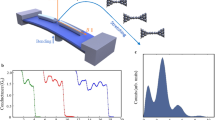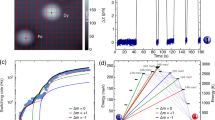Abstract
Nanomagnets, namely arrays of a few exchange-coupled atomic magnetic moments, possess a rich variety of magnetic properties and are explored as constituents of nanospintronics technologies. They have been realized as magnetic clusters or molecular nanomagnets. Individual nanomagnets, built from magnetic atoms adsorbed onto a nonmagnetic surface (adatoms) coupled by Ruderman–Kittel–Kasuya–Yosida exchange, exhibit a high level of versatility resulting from distance-dependent interactions. Here, we combine spin-resolved scanning tunnelling microscopy, atom manipulation and simulations to tailor nanomagnets ranging from linear chains to complex two-dimensional arrays and perform magnetometry in an atom-by-atom fashion. Distinct ground states of each chain, depending on even or odd numbers of constituent atoms, and magnetic frustration within the arrays have been observed directly. Our work demonstrates real-space access to the magnetic states of tailored nanostructures providing an approach to tackling open fundamental questions in magnetism.
This is a preview of subscription content, access via your institution
Access options
Subscribe to this journal
Receive 12 print issues and online access
$209.00 per year
only $17.42 per issue
Buy this article
- Purchase on Springer Link
- Instant access to full article PDF
Prices may be subject to local taxes which are calculated during checkout





Similar content being viewed by others
References
Gatteschi, D. & Sessoli, R. Molecular Nanomagnets (Oxford Univ. Press, 2006).
Bucher, J. P., Douglass, D. C. & Bloomfield, L. A. Magnetic properties of free cobalt clusters. Phys. Rev. Lett. 66, 3052–3055 (1991).
Lau, J. T., Föhlisch, A., Nietubyc`, R., Reif, M. & Wurth, W. Size-dependent magnetism of deposited small iron clusters studied by X-ray magnetic circular dichroism. Phys. Rev. Lett. 89, 057201 (2002).
Manoharan, H., Lutz, C. & Eigler, D. Quantum mirages formed by coherent projection of electronic structure. Nature 403, 512–515 (2000).
Gambardella, P. et al. Ferromagnetism in one-dimensional monatomic metal chains. Nature 416, 301–304 (2002).
Knorr, N. et al. Long-range adsorbate interactions mediated by a two-dimensional electron gas. Phys. Rev. B 65, 115420 (2002).
Silly, F. et al. Creation of an atomic superlattice by immersing metallic adatoms in a two-dimensional electron sea. Phys. Rev. Lett. 92, 16101 (2004).
Hirjibehedin, C. F., Lutz, C. P. & Heinrich, A. J. Spin coupling in engineered atomic structures. Science 312, 1021–1024 (2006).
Loth, S., Baumann, S., Lutz, C. P., Eigler, D. M. & Heinrich, A. J. Bistability in atomic-scale antiferromagnets. Science 335, 196–199 (2012).
Slonczewski, J. C. Current-driven excitation of magnetic multilayers. J. Magn. Magn. Mater. 159, L1–L7 (1996).
Kiselev, S. I. et al. Microwave oscillations of a nanomagnet driven by a spin-polarized current. Nature 425, 380–383 (2003).
Krause, S., Berbil-Bautista, L., Herzog, G., Bode, M. & Wiesendanger, R. Current-induced magnetization switching with a spin-polarized scanning tunneling microscope. Science 317, 1537–1540 (2007).
Wernsdorfer, W. & Sessoli, R. Quantum phase interference and parity effects in magnetic molecular clusters. Science 284, 133–135 (1999).
Leuenberger, M. N. & Loss, D. Quantum computing in molecular magnets. Nature 410, 789–793 (2001).
Troiani, F. et al. Molecular engineering of antiferromagnetic rings for quantum computation. Phys. Rev. Lett. 94, 207208 (2005).
Yan, S., Huse, D. A. & White, S. R. Spin-liquid ground state of the S=1/2 Kagome Heisenberg antiferromagnet. Science 332, 1173–1176 (2011).
Balents, L. Spin liquids in frustrated magnets. Nature 464, 199–208 (2010).
Lounis, S., Mavropoulos, P., Dederichs, P. H. & Blügel, S. Noncollinear Korringa–Kohn–Rostoker Green function method: Application to 3d nanostructures on Ni(001). Phys. Rev. B 72, 224437 (2005).
Bergman, A., Nordström, L., Burlamaqui Klautau, A., Frota-Pessôa, S. & Eriksson, O. Magnetic structures of small Fe, Mn, and Cr clusters supported on Cu(111): Noncollinear first-principles calculations. Phys. Rev. B 75, 224425 (2007).
Lounis, S., Dederichs, P. H. & Blügel, S. Magnetism of nanowires driven by novel even–odd effects. Phys. Rev. Lett. 101, 107204 (2008).
Ruderman, M. A. & Kittel, C. Indirect exchange coupling of nuclear magnetic moments by conduction electrons. Phys. Rev. 96, 99–102 (1954).
Kasuya, T. A theory of metallic ferro- and antiferromagnetism on Zener’s model. Prog. Theor. Phys. 16, 45–57 (1956).
Yosida, K. Magnetic properties of Cu–Mn alloys. Phys. Rev. 106, 893–898 (1957).
Stepanyuk, V. S., Niebergall, L., Longo, R. C., Hergert, W. & Bruno, P. Magnetic nanostructures stabilized by surface-state electrons. Phys. Rev. B 70, 075414 (2004).
Zhou, L. et al. Strength and directionality of surface Ruderman–Kittel–Kasuya–Yosida interaction mapped on the atomic scale. Nature Phys. 6, 187–191 (2010).
Stepanyuk, V. S., Negulyaev, N. N., Niebergall, L. & Bruno, P. Effect of quantum confinement of surface electrons on adatom–adatom interactions. New J. Phys. 9, 388 (2007).
Brovko, O. O., Ignatiev, P. A., Stepanyuk, V. S. & Bruno, P. Tailoring exchange interactions in engineered nanostructures: An ab initio study. Phys. Rev. Lett. 101, 036809 (2008).
Ising, E. Beitrag zur Theorie des Ferromagnetismus. Zeitschrift für Physik A 31, 253–258 (1925).
Eigler, D. M. & Schweizer, E. K. Positioning single atoms with a scanning tunnelling microscope. Nature 344, 524–526 (1990).
Meier, F., Zhou, L., Wiebe, J. & Wiesendanger, R. Revealing magnetic interactions from single-atom magnetization curves. Science 320, 82–86 (2008).
Khajetoorians, A. A. et al. Itinerant nature of atom-magnetization excitation by tunneling electrons. Phys. Rev. Lett. 106, 037205 (2011).
Wiebe, J. et al. A 300 mK ultra-high vacuum scanning tunneling microscope for spin-resolved spectroscopy at high energy resolution. Rev. Sci. Instrum. 75, 4871–4879 (2004).
Simon, E. et al. Exchange interaction between magnetic adatoms on surfaces of noble metals. Phys. Rev. B 83, 224416 (2011).
Ignatiev, P. et al. Magnetic ordering of nanocluster ensembles promoted by electronic substrate-mediated interaction: Ab initio and kinetic Monte Carlo studies. Phys. Rev. B 80, 165408 (2009).
Kevan, S. D. & Gaylord, R. H. High-resolution photoemission study of the electronic structure of the noble-metal (111) surfaces. Phys. Rev. B 36, 5809–5818 (1987).
Papanikolaou, N., Zeller, R. & Dederichs, P. H. Conceptual improvements of the KKR method. J. Phys. Condens. Matter 14, 2799–2823 (2002).
Liechtenstein, A., Katsnelson, M., Antropov, V. & Gubanov, V. Local spin density functional approach to the theory of exchange interactions in ferromagnetic metals and alloys. J. Magn. Magn. Mater. 67, 65–74 (1987).
Mazurenko, V. V., Iskakov, S. N., Rudenko, A. N., Anisimov, V. I. & Lichtenstein, A. I. Renormalized spectral function for Co adatom on the Pt(111) surface. Phys. Rev. B 82, 193403 (2010).
Bode, M. et al. Chiral magnetic order at surfaces driven by inversion asymmetry. Nature 447, 190–193 (2007).
Slonczewski, J. C. Origin of biquadratic exchange in magnetic multilayers. J. Appl. Phys. 73, 5957–5962 (1993).
Wieser, R., Vedmedenko, E. Y. & Wiesendanger, R. Entropy driven phase transition in itinerant antiferromagnetic monolayers. Phys. Rev. B 77, 064410 (2008).
Wang, R. F. et al. Artificial ‘spin ice’ in a geometrically frustrated lattice of nanoscale ferromagnetic islands. Nature 439, 303–306 (2005).
Fennell, T., Bramwell, S. T., McMorrow, D. F., Manuel, P. & Wildes, A. R. Pinch points and Kasteleyn transitions in kagome ice. Nature Phys. 3, 566–572 (2007).
Bramwell, S. T. & Gingras, M. J. P. Spin ice state in frustrated magnetic pyrochlore materials. Science 294, 1495–1501 (2001).
Crommie, M. F., Lutz, C. P. & Eigler, D. M. Confinement of electrons to quantum corrals on a metal surface. Science 262, 218–220 (1993).
Khajetoorians, A. A., Wiebe, J., Chilian, B. & Wiesendanger, R. Realizing all-spin-based logic operations atom by atom. Science 332, 1062–1064 (2011).
Acknowledgements
Financial support from the European Research Council (ERC) Advanced Grant ‘FURORE’, by the Deutsche Forschungsgemeinschaft via the SFB668, as well as by the city of Hamburg via the cluster of excellence ‘Nanospintronics’ is gratefully acknowledged. S.L. acknowledges the support of the HGF-YIG Programme Funsilab—Functional Nanoscale Structure Probe and Simulation Laboratory (VH-NG-717). S. B. acknowledges support by the Helmholtz Association via grant POF-HGF-FIT. We would like to thank D. L. Mills, E. Y. Vedmedenko, R. Wieser, K. Them, P. H. Dederichs and N. P. Konstantinidis for fruitful discussions.
Author information
Authors and Affiliations
Contributions
A.A.K. and B.C. performed the experiments. A.A.K., B.C. and J.W. carried out the data analysis. S.L. carried out and analysed the ab initio calculations. J.W. and A.A.K wrote the paper. All authors discussed the results and commented on the manuscript.
Corresponding author
Ethics declarations
Competing interests
The authors declare no competing financial interests.
Supplementary information
Supplementary Information
Supplementary Information (PDF 3997 kb)
Supplementary Information
Supplementary Information (MOV 4866 kb)
Rights and permissions
About this article
Cite this article
Khajetoorians, A., Wiebe, J., Chilian, B. et al. Atom-by-atom engineering and magnetometry of tailored nanomagnets. Nature Phys 8, 497–503 (2012). https://doi.org/10.1038/nphys2299
Received:
Accepted:
Published:
Issue Date:
DOI: https://doi.org/10.1038/nphys2299
This article is cited by
-
Atomically engineering metal vacancies in monolayer transition metal dichalcogenides
Nature Synthesis (2024)
-
Universal quantum control of an atomic spin qubit on a surface
npj Quantum Information (2023)
-
An atomic Boltzmann machine capable of self-adaption
Nature Nanotechnology (2021)
-
Trends in the hyperfine interactions of magnetic adatoms on thin insulating layers
npj Computational Materials (2021)
-
Long range and highly tunable interaction between local spins coupled to a superconducting condensate
Nature Communications (2021)



